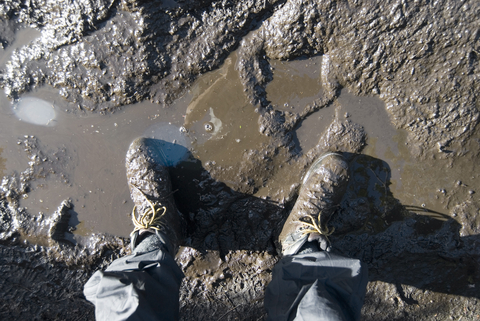Every Day Is Halloween

Consider the way I spent my time yesterday:
I had breakfast in an upscale eatery to discuss teaching a class. I went through a phone interview with a publication’s editor. I hung up the phone and headed over to a job site I knew would be a total mess after a night that had given us an unexpected inch of rain. Adding to the uncertainty, I was to meet a crew I’d never worked with before.
After slogging through the mud for a couple hours, I cleaned myself up and went to a downtown hotel to give a luncheon talk. Once that was done, I went back to the job site for another stretch of hard, heavy work. Things were getting under control, but there was a lot to communicate and I had to feel my way through language barriers to get my points across.
I went home to shower and prepare myself for a presentation about an elaborate waterfeature for a high-end client in an exclusive, gated community. Once we’d worked through all the details, I headed home to bed.
In the course of the day, I changed physical costumes a number of time, but even more often, I changed my psychological attire.
Quick-Change Artist
It’s a plain fact: I wouldn’t go to a muddy job site and expect to get much of anything done in a nice suit and leather shoes. Conversely, I wouldn’t inflict shorts and muddy boots on a school administrator, a luncheon audience or an upscale client.
Not so plain a fact is that each set of clothes I wore yesterday was only part of my total outfit, and that I needed to be just as conscious of my psychological get-ups as I was of the physical ones.
Let’s consider an example of how this plays out: Let’s say the rain had caught me totally off guard and had done some damage that wasn’t my client’s fault. I’ll be covering the cost of remediation myself, but things are tight and this throws substantial money worries into my issues of the day.
Let’s say I stew about this obligation through my shower and head off to meet my well-heeled client, resentful that he has more money than he could ever count: My attitude will suffer, my enthusiasm will suffer, my presentation will suffer – and ultimately I won’t be persuasive enough to win a project that would easily get me out of the hole that I’d found myself in earlier that morning.
Adjusting the Outfits
These sorts of scenarios occur from time to time, and we can’t anticipate when. And they happen not only to designers and builders: They also happen with homeowners and property managers we meet with, and they definitely cast an unanticipated pall over the proceedings.
For my part, I know well enough that I have to adjust my mentality to get through these situations in positive ways. I need to do what I always do – change my clothes, drive around the neighborhood to set a context, and hope for a good break such as an open garage door at my clients’ home so I can get an idea how they really live.
Especially when I’m hurting psychologically, I put a premium on being observant. I pause at the front door to see if my clients remove their shoes on entering and follow suit. I look for books, music collections, musical instruments, art, furniture and anything else that gives me even a fleeting insight into their personal styles, levels of education, tastes and ways of life.
I do so because I’ve found that this is the best way to begin a working relationship. I’ve also found that the mental exercise helps me reset my own attitudes and forget my daily cares. I know that if I kept dwelling on money woes or car troubles or a personal conflict, I just wouldn’t do well in my appointment. So instead, I focus on what I like about my clients and respond as best I can to their personalities, and especially to any quirks or idiosyncrasies I can spot. (And that’s usually not hard to do!)
Accentuate the Positive
What I’m suggesting, in addition to dealing with physical environments, is that we, as watershape designers and builders who work with physical environments, are also working with mentalities and broad psychological environments. If our task is to help clients bring beauty and serenity to their lives with outstanding waterfeatures, we need to leave our baggage at the door, look for positives and find the best path.
When I find that place, I relax, my clients relax, the mood lightens – and what could have devolved into a meeting in which money was a dominant subtext becomes one in which light touches and humor set the tone.
As I see things, it’s about changing my mind into appropriate “clothing” as I work through a day. If I get it right, communicating with people who want to hire me as well as people who are working on my behalf becomes much easier, as does dealing with assumptions, prejudices and attitudes in meetings, at luncheons and on job sites.
The closet is pretty packed, but all of the outfits are important.
Dave Garton, owner of Lawnchair Watershapes in Denver, is an expert pond and stream builder as well as an in-demand business speaker and coach. He may be reached at davespeaks@aol.com.










